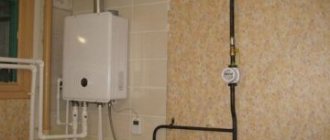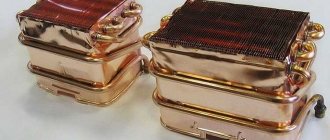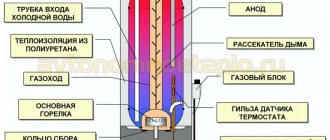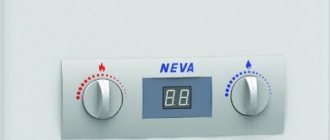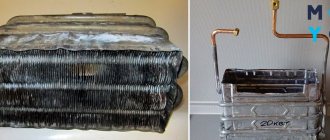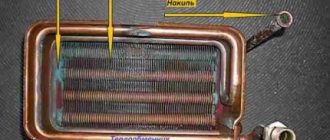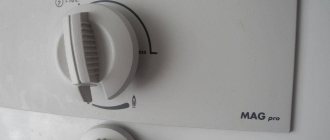An ordinary apartment, a country house or a small dacha - the choice of a gas water heater can be relevant for any residential property. This type of water heater is economical and convenient because it can quickly heat the required amount of water. Its dimensions are minimal, and in terms of energy consumption, speakers are usually more profitable when paying for utilities. It should also be noted that the best instantaneous gas water heaters are capable of providing high purity of hot water, which conventional pipelines cannot always boast of. You can connect one device to several points at once: bath and shower, kitchen sink.
No. 1. Types of gas water heaters: instantaneous and storage
Depending on the device, gas water heaters are divided into two types:
- flow-through;
- cumulative.
Wall-mounted instantaneous water heaters are popularly called geysers . They are the most widespread. Storage-type devices are practically not used in domestic spaces.
Instantaneous gas water heaters
The geyser does not have a storage tank and is designed for instant heating of water. Inside the unit there is a heat exchanger through which a water tube passes. There is a gas burner under the heat exchanger. As a result of gas combustion, heat is generated, which heats the water passing through the heat exchanger. Exhaust gases are collected in a collector and discharged to the street. This is a basic diagram of how the speaker works, but the operating features of some components may differ from model to model.
In the simplest water heaters light the burner manually; in more expensive models, automatic ignition is provided: as soon as someone turns on the hot water tap, the heater will start working, and turn off when the tap is closed. The water temperature can be regulated either by a simple gearbox or by sophisticated modern electronics.
From your school chemistry course, you must remember that to burn gas, you need oxygen, which is contained in the air. Simple household speakers are equipped with an open combustion chamber and receive air from the room. Combustion products are discharged either through a conventional chimney (an option for private houses) or through a horizontal pipe with a fan providing forced draft. The latter option is used in apartment buildings.
Gas water heaters are equipped with a multi-stage safety system , so they cannot cause any harm, unless, of course, the installation was carried out correctly and you do not violate safety regulations.
Advantages of geysers:
- compactness . Even the most powerful unit, which is capable of heating water for several water intake points, will not take up much space and can be very neatly hidden in the kitchen;
- economy . Heating water using gas is much cheaper than using electricity. Moreover, in some cases, preparing hot water in this way is even cheaper than its centralized supply;
- ability to work with several water intake points. To ensure water heating for 3-4 or more points of water consumption using a flow-through electric heater, you will have to take a device with a power of more than 8 kW, which means that a network with a voltage of 220 V will not be enough - wiring with a three-phase voltage of 380 V will be required. , designed to work with the same number of water intake points, can be connected to ordinary city gas lines - their power will be sufficient.
Some manage to install the speaker even in rooms not connected to a gas pipeline, since there are models that can be powered from a gas cylinder .
Gas water heaters also have disadvantages.:
- more complex installation when compared with electric heaters. You can’t do this on your own – you need to involve specialists and obtain special permission;
- the gas main must have sufficient capacity. As a rule, this is not a problem - in most apartments there will be enough power. Where only a gas stove is installed, the network power may be insufficient;
- combustion products must be removed somewhere , so the construction of a chimney will be required. It will be easiest for residents of private houses and the top floors. The rest will have to build a chimney along the outer wall of the house or install a turbine column and punch a hole in the wall;
- danger caused by improper use. To minimize risks, purchase a speaker with automatic protection. By the way, all modern devices and most of those released decades ago are equipped with the necessary security systems. In addition, it is important to ensure the flow of the required amount of fresh air: for 1 unit of volume of burned gas, 10 units of volume of supply air should be supplied.
Storage gas water heaters
Such devices are similar in design to electric boilers . The only difference lies in the source of heat: instead of electricity, gas is used here. The basis of such a unit is a storage tank where a supply of hot water is stored. A tube passes through the tank - this is a heat exchanger, inside which hot gas combustion products move. A burner is installed at the bottom of the tube, where the combustion process takes place. So that the gases, moving upward, have time to give up all their heat, the heat exchanger receives a complex design with dividers.
Tank volume ranges from 50-500 liters , but the most widespread models are 100 and 200 liters. For a family of 2-3 people, a unit with a volume of 80-150 liters is suitable. The tank receives reliable thermal insulation, so a once heated supply of water can be stored for a relatively long time - there is no need to turn on the device every time.
The main advantages of storage gas water heaters include:
- efficiency;
- availability of a constant supply of hot water;
- possibility of installation where the gas supply line is weak;
- ability to work with a large number of water intake points.
Such units take up a lot of space , but this is not their main drawback. They are quite expensive , they are not widespread in our area, so their range is extremely modest. Most people opt for instantaneous heaters or double-circuit boilers. Due to the low popularity of this type of unit, we will focus our attention on how to choose a geyser - a device with a flow-through type of heating.
How to choose the most suitable model
A gas water heater for an apartment or a gasified house may not have the function of switching to liquefied gas. The main thing is that the security system is at the highest level.
For a summer residence, flow-through models using bottled gas would be an ideal option, since hot water consumption is kept to a minimum.
The security system should include at least the most important points, for example, flame detectors, sensors for overheating and chimney backdraft.
The ignition system does not play a particularly important role.
It all depends on your preferences and wishes. The same applies to size, color and other external parameters. Advertising from sponsors: // // //
No. 2. Gas water heater power
The power of the geyser is indicated in kW. It is directly related to the performance of the equipment and indicates how many liters of water per minute the column can heat. It is worth noting that the best geyser is not necessarily the most powerful device. It all depends on how many people live in the apartment, and how many of them can use hot water at the same time (or how many hot water faucets are installed). It is believed that one mixer is capable of flowing 6-7 l/min. It is enough to multiply this parameter by the number of taps, add a small margin and get the result. The power is indicated either on the column itself or in the technical documentation for it. For example, a column with a power of 23-24 kW allows you to heat about 14 liters of water per minute to a temperature of about 25 degrees.
Based on power, speakers are divided into several types:
- 17-20 kW – minimum power sufficient to supply one water intake point, i.e. you can either take a comfortable shower or wash the dishes - it will be difficult to do both at the same time. Their productivity is 9-10 l/min, no more. Option for a small family or one person;
- 20-26 kW - medium power columns, heat 15-20 l/min and are suitable for heating water to a comfortable temperature for 2-3 points of water consumption. The most popular option;
- more than 26 kW - powerful units for large families and private homes.
In pursuit of power, do not lose common sense and do not forget to take into account the water pressure indicator . There is no point in buying a column designed to heat 25 liters of water per minute if the water supply network is not capable of providing such pressure.
No. 3. Gas water heater ignition type
The type of ignition is one of the most important parameters of the column. It determines how often you will approach the device, as well as how safe and economical the process of generating a flame will be. types of ignition can be used in geysers :
- manual type of ignition is practically not used in currently produced columns - this method has become a legend, since it was not very safe and extremely inconvenient, especially if the unit was located in a hard-to-reach place. There is no point in dwelling in detail on manual ignition;
- piezo ignition - an improved version of the manual method. Here the spark comes not from a match, but when a special button is pressed. With its help it lights up pilot burner (as in the case of manual ignition). It is always on when in standby mode. When someone turns on the hot water, the main burner lights up, and after turning off the hot water, it goes out. Due to the fact that the pilot burner always maintains the flame, It’s impossible to call such speakers economical. But devices with such ignition are inexpensive and are completely non-volatile – for areas with frequent power outages, this is the best option. In fairness, it is worth noting that the financial losses from the constant burning of the pilot burner are not particularly significant, especially in modern columns;
- electric ignition. The supply of gas and the start of its combustion occurs only when someone in the apartment turns on the hot water valve. Until this moment, gas is not consumed. When the tap is closed, access to the gas is blocked by a special valve, and combustion does not occur. That is why such columns are considered the most economical and modern, and the absence of the need to ignite the flame (even if this is done without a match, but only with a button) is great plus in terms of ease of use. Minus - higher price such speakers are also dependent on the availability of electricity, but in some models we managed to get rid of the last disadvantage.
Columns with electric ignition can be divided into two types: volatile and non-volatile. In volatile ones, the ignition system is connected to the household electrical network. If you live in a city apartment and do not experience any special problems with the supply of electricity, then this is quite a good option. In non-volatile electric speakers, ignition can be implemented in several ways:
- using batteries. It is advisable to use powerful alkaline batteries and change them regularly, since a decrease in supply voltage can cause characteristic popping noises when starting the burner. As a rule, the charge level is displayed on the display. In some speakers, batteries are used as a backup ignition system;
- hydrodynamic ignition. Energy sufficient for ignition is obtained by operating a small hydrogenerator. As soon as you turn on the hot water tap, the turbine begins to rotate and generate energy for ignition, which takes a matter of seconds. Convenient and practical, but dispensers with a hydrogen generator are not cheap, and if something happens, repairs will be difficult.
No. 4. Combustion chamber type
To choose a gas water heater, you need to pay attention to a lot of technical details, and the type of combustion chamber is one of the most important points. There are only two options here:
- open combustion chamber;
- closed combustion chamber.
Open chamber speakers are the simplest and cheapest. They use air from the room in which the device hangs to burn gas. The intake is carried out through the holes at the bottom of the column. Such units are installed in kitchens or in separate utility rooms (an excellent option for owners of private houses). Combustion products are removed through the chimney due to natural draft. These types of devices are characterized by minimal noise during operation, but are more suitable for private homes, as they require connection to a chimney. In addition, the room where the device will be installed must be provided with adequate ventilation.
Columns with a closed combustion chamber receive air from the street. The chimney in such units is horizontal, goes out through the wall and is represented by a coaxial pipe (pipe in a pipe). Through the inner part of the pipe, combustion products are removed to the street using a fan, and air is supplied to the column through the outer pipe. You can install such a unit in any room, it is safer, but you will have to pay more for such a speaker, and the operation of the fan depends on the availability of electricity and is accompanied by slight noise.
What to do?
Problem
Solutions
The mesh filter is located “at the inlet” of the heat exchanger. You can remove the blockage by removing this part and cleaning it with a stiff brush under running water. If during the cleaning process you notice that the filter is damaged, replace it with a new one.
Scale in the heat exchanger
It is not recommended to use special products that are designed to remove and prevent the formation of scale in geysers. They have an aggressive chemical composition that destroys metal surfaces. “Folk” remedies, for example, simple citric acid dissolved in hot water, are much more effective and safer.
Blockage in pipes
If a blockage has formed in the pipe through which hot water flows, you can try to remove it by running the cold water back. To do this, you need to remove the plug, place a container under the column to collect water and open both taps. Then pinch the spout with your finger. There is a chance that cold water, moving in the opposite direction, will push the clog forward.
If small debris has penetrated further than the gas water heater pipes, it may well get inside the mixer. The most susceptible to blockages are the filter, the axle box and the thin rubber hose. You can fix the problem if you disassemble the mixer and visually inspect each part for the presence of foreign objects. Accumulations of dirt are usually easily washed off with running water.
Our article will help you choose the best geyser: powerful, compact and functional - so that there is always hot water in the tap.
No. 5. Removal of combustion products
We have already partially discussed this issue above, but now we will dwell in a little more detail. Depending on the type of carbon monoxide removal, there are:
- classic, with chimney . Great for homes that already have a chimney. Otherwise, it will have to be built separately. For residents of apartment buildings, this option is in most cases impossible to implement;
- chimneyless, or turbine . Combustion products are discharged through a pipe, a hole for which is made in the wall. Combustion products are drawn out due to the operation of the fan.
The room in which the speaker is located must be well ventilated. If plastic windows were installed, you will have to equip them with a ventilation valve.
No. 6. Column heat exchanger type
The durability and wear resistance of the column is directly related to the material used to make the heat exchanger:
- steel heat exchanger It is inexpensive, weighs decently, and is relatively reliable in operation. It is better to choose a model where the heat exchanger is made of stainless steel;
- highly purified copper resembles steel in its basic properties, but has higher heat transfer, so it will be possible to extract the maximum benefit from each cubic meter of gas;
- ordinary copper heats up unevenly, due to impurities. That is why many manufacturers cover the heat exchanger with heat-resistant paint, but it can only hold back destructive processes in the heat exchanger for a while.
It turns out that stainless steel and purified copper are the preferred options.
What are the standard sizes?
The market offers water heaters from dozens of manufacturers - European, domestic, and Chinese. Comparing the technical characteristics, you can be sure: each brand and even each model within the same series may differ in dimensions. Manufacturers are not limited by standards when it comes to sizes; each is guided by the parameters of the devices and expediency. The specifications indicate three parameters - height, width and depth. When choosing an option for a specific area, you need to measure in advance the parameters of the place prepared for installation so that the purchased device fits. Nevertheless, there are sizes that are more common than others; they can be conditionally called standard for average gas-fired water heaters:
- 700x450x250 mm is the most popular size;
- 760x350x250 mm and 655x350x220 mm are common sizes.
The peculiarity of modern speakers is complete safety and low demands on placement conditions. They can easily be placed between kitchen cabinets or built into one of them. It can be difficult to choose an option that meets both technical and dimensional requirements. It is more convenient when you first buy a water heater, and only then assemble the cabinets, knowing the dimensions of the equipment. That is why you should not buy ready-made kitchen furniture; it is better to make it to order.
No. 7. Water and gas pressure
For each column, the data sheet specifies two main water pressure parameters: the minimum at which the unit will turn on, and the maximum - the pressure that the heat exchanger can withstand without losing its integrity. It is advisable to clarify all the parameters of your water supply network before choosing a gas water heater. For city apartments where water heaters are used (and these are mostly Khrushchev and Stalin buildings, i.e. old housing stock with worn-out communications), it is better to choose a unit that can operate with minimal water pressure . Therefore, pay attention to those devices that can heat water at a pressure of as low as 0.15 bar.
High pressure can be destructive to the column, and water hammer, alas, is not uncommon. Buy units that can withstand a short-term increase in network pressure up to 11-12 bar.
Also, do not forget to check what gas pressure the dispenser can operate with. In domestic gas pipelines, the gas pressure is lower than in European ones (13 mbar versus 20 mbar), so when buying a dispenser from a European manufacturer, you need to inquire for which market it was produced, and whether it has a gas reducer installed in order to maintain constant pressure.
No. 8. Burner type and power modulation
Burners in geysers can be of two types:
- with constant power . The simplest option, the main advantage of which is its low cost. When changing the water pressure, you will have to manually change the temperature on the column, and you can get tortured. If you do not change the temperature, the water can flow at a scalding temperature. Let's say your neighbor turned on the water or someone flushed the toilet. The water pressure has decreased, but the flame strength has remained the same, so the reduced amount of water that will flow through the heat exchanger will heat up to uncomfortably high temperatures;
- with modulated power . Everything here is much more modern. You just need to enter the desired water temperature, and the flame power will be adjusted depending on the water pressure. This is the preferred option. Of course, water temperature control is present on all water dispensers, but conventional devices cannot adapt to changes in gas pressure and pressure, and units with modulated power will produce water with clearly required parameters under almost any conditions. Such speakers are more expensive, but they are not only more comfortable to use, but also more economical.
Of course, the preferred option would be a burner with modulating power.
Placement in the kitchen
The most rational and aesthetic option is to install the device between kitchen cabinets. It will fit harmoniously into the kitchen interior without being dissonant with the decor. Here it is important to decide what comes first - the dimensions of the speaker or the dimensions of the furniture. If, for example, the set has narrow cabinets, it will be difficult to fit a powerful device in one of them.
In addition to aesthetics, it is important to consider fire safety. Although water heaters are protected from all possible troubles, the operating rules provide for certain requirements when installing them:
- the gap between the water heater and the walls of the cabinets is at least 3 cm;
- The walls of cabinets located in close proximity to the gas device must be made of non-combustible materials.
If the water heater does not harmonize with the interior of the kitchen, the column can be hidden in one of the cabinets. The main thing is that not only the height and width, but also the depth of the model match - so that the cabinet door can be closed without difficulty. It is also important to fulfill all fire safety conditions:
- the device should not touch the cabinet walls;
- there should be enough space in the closet for ventilation;
- there should be no upper or lower horizon in the cabinet - only a door hiding the device;
- you can add a bottom panel, but be sure to have holes for ventilation.
No. 9. Gas water heater security system
Many people are still afraid to use geysers. Data on real estate sales show that apartments with similar equipment are 15% cheaper than similar ones, but without gas water heaters, and 70% of buyers do not even consider buying such housing. If you approach the selection and operation of a gas water heater wisely, then all risks can be minimized. It is important that the column automatically turns off when there is no supply of water, gas or the necessary draft, and does not allow carbon monoxide poisoning. To achieve this, modern units are literally packed with all kinds of security systems:
- the ionization sensor turns off the device when the gas supply is stopped;
- The combustion sensor also turns off the column if the flame goes out. Ionization and combustion sensors can be used in pairs;
- the draft detector will not allow the heater to be turned on or will turn it off if there is no draft in the chimney, protecting the home from filling with carbon monoxide;
- the flow detector ensures the normal functioning of the column and turns it on when someone turns on the hot water tap;
- The overheating sensor turns off the column if the water temperature reaches a threshold value. Protects the heat exchanger from rupture and a person from burns;
- a low water pressure detector will not allow the water heater to turn on if the pressure in the water supply is insufficient, thereby protecting the heat exchanger from burning out;
- an emergency pressure relief valve protects the column from increased water pressure;
- A cold and hot water temperature sensor is necessary to correctly set the temperature of the water coming out of the tap.
Neva 6011
Neva 6011 from the manufacturer from St. Petersburg is one of the latest in the model range. buy a Neva of this modification for approximately 12-13 thousand rubles. Which is very beneficial. Since Bosh products with similar characteristics cost almost twice as much. With all this, Neva 6011 is not inferior to its foreign analogues. The automation of this gas equipment is made in Japan and is extremely reliable. Its strength reserve allows it to operate without breakdowns for more than 10 years. Neva 6011 has a stylish and modern appearance. It copes with its task perfectly even at extremely low pressure in the water supply system.
Performance characteristics of Neva 6011:
- rated power, kW – 21;
- weight, kg – 11;
- productivity, l/min – 11;
- minimum operating pressure, bar – 0.15.
The dimensions of the model under consideration are significantly different from similar products of the type under consideration, but with less power. Dimensions Neva 6011:
- height, mm – 565;
- width, mm – 290;
- depth, mm – 220.
Rice. 4 Neva 6011
The model under consideration has a large number of different advantages, these include the following:
- high accuracy of temperature control – up to 10C;
- there is a digital information display;
- all adjustments are made using special buttons;
- if there is a malfunction, the automation displays a corresponding message with a code on the display;
- there is a built-in safety system - if the flame goes out, the gas supply is turned off automatically.
The safety of the column is especially important - a multi-level protection system eliminates the very possibility of a fire. The self-diagnosis unit allows the user to determine the cause of the malfunction without any difficulty - if there are problems, a corresponding notification is displayed on the screen.
Video review of the gas boiler Neva 6011.
No. 10. The best manufacturers of geysers
It is difficult to argue with the well-known fact that famous companies produce high-quality, reliable and durable equipment. When safety and comfort are at stake, it is better to overpay a little, but sleep peacefully, so we recommend paying attention to gas water heaters from the following manufacturers:
- Bosch, Germany - high-quality reliable equipment with the ability to maintain water temperature at variable pressure. There are models of varying power;
- Beretta , Italy - wide range of geysers. Each model is presented in a whole range of capacities. The manufacturer also pays attention to design, so for those for whom the main thing is not to spoil the interior, these units are recommended for use;
- Zanussi , Italy - reliable and inexpensive equipment, most models are made in a classic style. Main advantages: economical gas consumption, low noise, copper heat exchanger, work with networks with low water pressure;
- Ariston , Italy - functional speakers at affordable prices. All components that are subject to increased loads are made of composite materials that are extremely resistant to corrosion;
- MORA-TOP , Czech Republic - a manufacturer with extensive experience, produces very high-quality speakers with reliable and durable heat exchangers. All stages of assembly are carried out in Europe, all parts are made in Europe, so you can trust these speakers. In addition, each model, both the most budgetary and the most expensive, uses a multi-stage security system;
- Vaillant, Germany - produces productive, unpretentious speakers that are great for use in our area;
- Electrolux , Sweden - speakers with copper heat exchangers, excellent functionality and affordable prices;
- Ladogaz , Russia - domestically produced speakers, which are manufactured using European technologies and are inexpensive. The models are quite economical and maximally adapted to our operating conditions;
- NEVA , Russia - a St. Petersburg company that has been producing geysers since the 90s, working to improve their design and constantly expand the model range. The speakers can work with minimal water and gas pressure, so in some cases they will be indispensable.
Finally, we note that there is no need to be afraid of geysers - you just need to learn how to choose them correctly and ensure compliance with the operating rules.
The article was written for the site.
Tags:Hot water, Heating boiler
